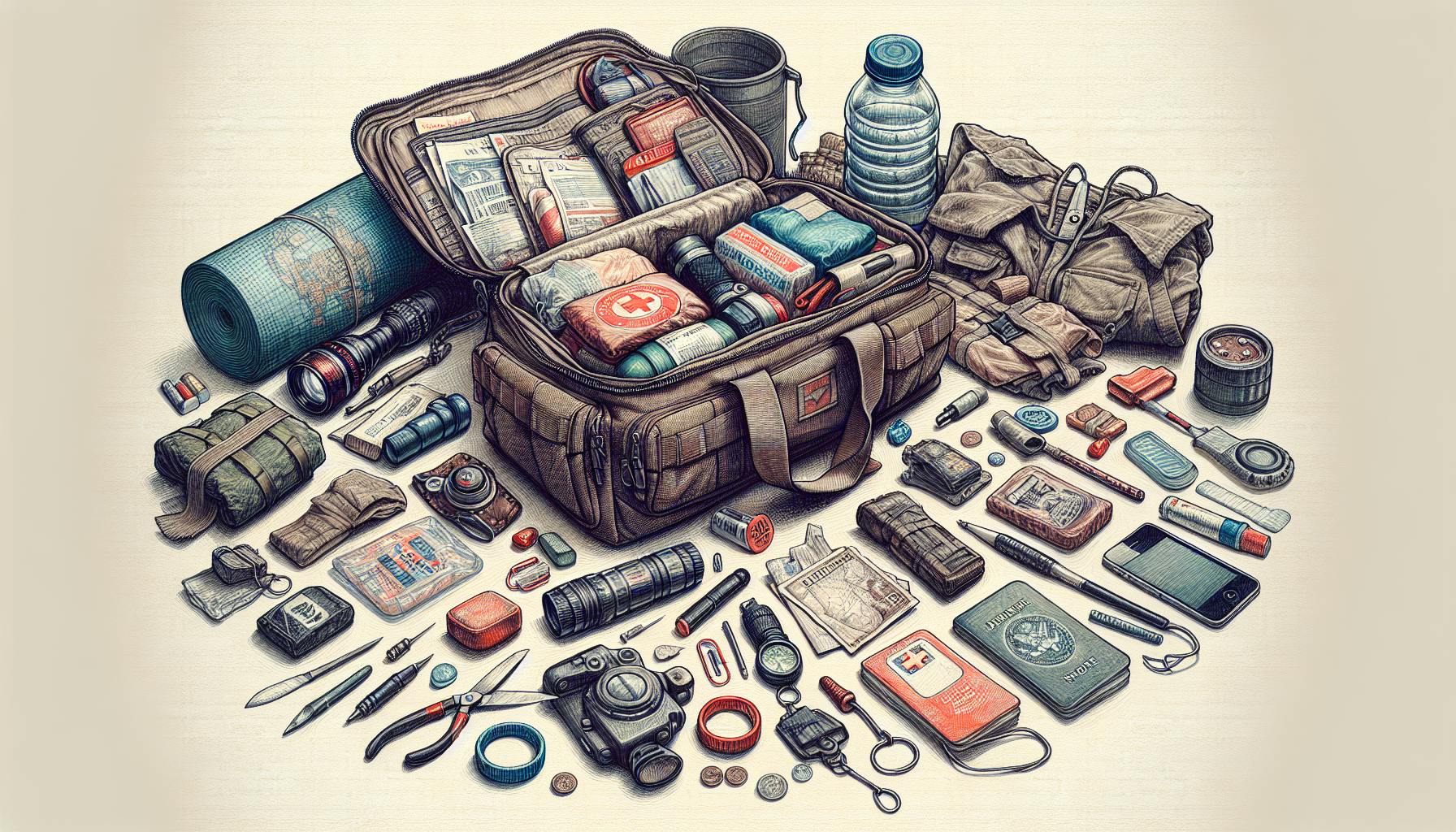When disaster strikes, having nutritious food on hand is crucial for health and survival.
This guide provides a comprehensive analysis of freeze-dried foods to equip you with the knowledge to build a balanced, nutritional emergency food supply.
You'll learn the nutritive value of various freeze-dried ingredients, how to store them for maximum freshness and shelf life, top food brands for emergencies, and tips for proper reconstitution and consumption when an emergency situation arises.
Introduction to Freeze Dried Food for Emergencies
Freeze dried foods can be a critical part of an emergency food supply. By removing almost all moisture, freeze drying allows food to be stored for years without refrigeration while retaining most of its nutritional value. This makes it an ideal emergency food.
Defining Freeze Dried Food
Freeze dried foods are created by freezing food and then removing almost all moisture through a vacuum process. This removal of water inhibits bacteria growth allowing food to be stored at room temperature for up to 25 years. Common freeze dried emergency foods include fruits, vegetables, meats, dairy products, and full meals.
Key Benefits for Emergencies
There are several key reasons freeze dried foods are useful for emergency preparedness:
- Long shelf life - Properly stored, freeze dried foods can last over 25 years
- Lightweight - The removal of water makes these foods very compact and portable
- Easy to prepare - Only requires adding hot water and waiting several minutes
This combination of long shelf life, low weight, and simplicity makes freeze dried foods perfect for bug out bags, emergency kits, and food storage.
Selecting the Best Freeze Dried Food
When selecting freeze dried food for your emergency supply, consider nutritional balance and dietary needs. Good options include:
- Freeze dried fruits and vegetables for vitamins and minerals
- Freeze dried meats for protein
- Dairy products like milk and cheese for calcium
- Balanced meals with carbs, protein, fruits and vegetables
Popular brands like Mountain House and Wise Foods offer freeze dried foods in all these categories.
Storing Properly for Maximum Shelf Life
To achieve the 25+ year shelf life freeze dried food advertises, proper storage is essential:
- Store in a cool, dry location around 60-70°F
- Use oxygen absorbers in containers to remove oxygen
- Protect containers from moisture, insects and rodents
With the right storage, you can rely on freeze dried foods being there when you need them even decades later.
Reconstituting Freeze Dried Food
Before eating, freeze dried foods must be reconstituted by adding water. Most products include exact water amounts and directions:
- Add hot or cold water depending on food
- Allow to sit for 5-10 minutes to rehydrate
- Stir occasionally while rehydrating
Following reconstitution directions ensures food rehydrates properly for consumption. And within minutes, you can turn that freeze dried food into a hot, tasty meal.
Is freeze-dried food good for an emergency?
Freeze-dried foods are an excellent choice when stocking your emergency food supply. Here's why:
Long Shelf Life
Properly stored, freeze-dried foods can last up to 25 years. This makes them perfect for an emergency when you may not be able to get to the grocery store for weeks or months. Freeze-dried foods will be there when you need them, even years down the road.
Lightweight & Compact
Freeze-dried foods are very lightweight because most of the water has been removed. This makes them easy to transport in a bug out bag or vehicle if you need to evacuate. They also take up little storage space compared to other emergency food options.
Nutrient Retention
The freeze-drying process allows foods to retain 97% of their nutritional value. This ensures you'll get quality nutrition to support health during an emergency situation. Freeze-dried fruits and vegetables provide fiber, vitamins, and minerals.
So if you're looking to stock up on emergency food, freeze-dried meals and ingredients are a smart choice. Just remember to store them properly in a cool, dark place to maximize shelf life. Rotating stock by expiration date is also recommended.
How do you make freeze-dried emergency food?
Freeze-drying is an effective way to preserve foods for emergency situations. Here is a simple 3-step process to make your own freeze-dried foods at home:
- Prepare the food you want to preserve. Fruits, vegetables, meats, and meals can all be freeze-dried. Cut foods into small, uniform pieces to ensure even drying.
- Place the prepared food in a single layer on trays or plates. Spread pieces out without overcrowding.
- Put trays in freezer and freeze food completely solid at the lowest possible temperature. Expect this to take 12-24 hours.
- Transfer frozen trays to a commercial or DIY freeze dryer. Maintain very low temperature and pressure to slowly remove all moisture. Expect 2-3 weeks for full freeze-drying.
- Check food intermittently until pieces are completely dry and brittle. Store in air-tight containers.
When stocking freeze dried food for emergencies, focus on nutritious ingredients with a long shelf life. Some good options include:
- Freeze-dried fruits and vegetables like strawberries, blueberries, sweet corn, green beans, broccoli, and carrots. These maintain vitamins and minerals.
- Freeze-dried meats like beef, chicken, turkey, and fish. Excellent sources of protein.
- Pre-made freeze-dried meals and entrees like chili, stew, pasta primavera, rice pilaf or mac and cheese. These are tasty and convenient.
No matter what foods you choose, proper freeze-drying and storage will give you nutritious, long-lasting emergency provisions.
How long does freeze-dried survival food last?
Freeze-dried food is an excellent option for long-term emergency food storage. The freeze-drying process removes 98-99% of the moisture from food, allowing it to last much longer than traditionally preserved foods.
Properly stored freeze-dried foods have a shelf life of 25-30 years. The extremely low moisture content prevents bacteria and mold growth that leads to spoilage. As long as the packaging remains intact and airtight, freeze-dried foods retain their nutritional value and taste for decades.
Some key advantages of stockpiling freeze-dried foods:
- Long shelf life makes it ideal for emergency preparedness
- Lightweight and compact compared to canned goods
- Easy to prepare by adding hot water
- Wide variety of freeze dried meats, fruits, vegetables, and full meals available
When building your emergency food supply, freeze-dried foods like [Mountain House meals](https://www.mountainhouse.com/) are a smart choice over canned goods. The extended shelf life ensures you have nutritious backup meals in any disaster scenario. Following proper storage methods, your freeze dried food for emergencies will retain quality and nutrition for years to come.
sbb-itb-b932644
What are dried foods for emergency preparedness?
Dried foods can be a crucial part of an emergency food supply. When properly stored, they have an extended shelf life compared to other foods, making them ideal for emergency preparedness kits. Some common dried foods that are easy to stock up on include:
- Dry, ready-to-eat cereals and granola: These are lightweight and nutritious. Look for whole grain options without added sugars.
- Dried fruits, nuts and trail mixes: Dried fruits like raisins, cranberries, and apricots provide fiber, vitamins and antioxidants. Nuts and seeds offer protein, healthy fats and minerals. Trail mixes with a mix of both make tasty, nutrient-dense snacks.
- Jerky: Dried meats like beef, turkey or salmon jerky pack a protein punch in a low weight, non-perishable form. They can be expensive though, so consider DIY options.
- Granola/protein bars: Another lightweight option for packing nutrients and calories into a small, durable form. Check labels for excessive sugars or artificial ingredients.
The key when stocking dried foods is balancing nutritional value with practical factors like shelf life, weight and convenience. Aim for nutrient diversity, not just empty calories. And don't forget to rotate and replace items as you use them!
Nutritional Analysis of Key Freeze Dried Foods
Freeze dried foods can provide balanced nutrition during emergencies if chosen carefully. When stocking up, focus on nutrient-dense options across food groups.
Protein Sources: Freeze Dried Meat Options
Freeze dried meats like beef, chicken, and fish are excellent sources of protein. Compared to fresh meats, freeze dried options are lower in fat while retaining protein and nutrients like iron, zinc and B vitamins. Popular picks like freeze dried ground beef or chicken breast have over 20g protein per serving. Mixing in some freeze dried meat ensures you get adequate protein intake in emergency situations.
Fruit and Vegetables
Stock up on a variety of freeze dried fruits and veggies. Produce like carrots, peas, broccoli, apples, berries, and bananas are great choices. They provide essential vitamins, minerals, antioxidants and fiber. Just 1/4 cup freeze dried strawberries offers 100% DV for vitamin C. Combining different freeze dried fruits and vegetables helps round out your nutrient intake.
Grains and Legumes
Rice, quinoa, oats, beans, lentils and pasta are freeze dried pantry staples. They supply energy and carbohydrates from complex carbs. Options like freeze dried rice or lentils also pack decent protein, especially beneficial if meat intake is lower. The fiber keeps digestion regular. Beans and lentils additionally provide iron, magnesium, potassium and folate.
Dairy Products
Freeze dried dairy supplies calcium, protein, vitamin D and more. Milk powder and butter powder conveniently store at room temperature. Cheese and egg crystals retain nutrients better than storing fresh eggs. Try adding freeze dried cheese to meals for a calcium and protein boost. Powdered milk or eggs also nicely supplement recipes.
Full Meals and Entrees
For quick and easy meal prep during emergencies, choose nutritionally balanced freeze dried entrees or meal kits. Look for variety across food groups like meat dishes with rice/pasta plus veggies. This conveniently combines complementary foods into single servings. Kits like beef stew, chicken fried rice, or pasta primavera ensure you get carbs, protein, fruits/veggies in one efficient package.
Building a Balanced Emergency Food Supply
Determine Daily Calorie Needs
To build an emergency food supply that meets your nutritional needs, first determine your daily recommended calorie intake. Consider factors like age, gender, height, weight, and activity level. Online calculators can help provide estimates. For example, an average moderately active 30-year-old male would need around 2,400 calories per day.
Balance Macronutrients
Aim for a balance of macronutrients from your freeze dried emergency food selections. Carbohydrates should make up around 50-60% of total calories. Shoot for 10-35% of calories from protein foods like meats, dairy, etc. Fat should account for 20-35% of calories.
Include All Micronutrients
In addition to macronutrient targets, ensure your choices provide at least 100% of the Daily Value (DV) for essential vitamins and minerals. Include freeze dried fruits, vegetables, whole grains, beans, nuts, seeds, eggs, and dairy products. Variety is key for sufficient micronutrients.
Account for Taste and Variety
Consider personal taste preferences when stocking up on freeze dried foods for emergencies. Also ensure some variety in flavors, textures, and types of foods to support long term palatability and adherence to your emergency eating plan.
Store Efficiently and Rotate Stock
Use oxygen absorbers in airtight containers to maximize shelf life of freeze dried emergency food supplies. Institute a first-in-first-out rotation system to avoid waste from expiration. Replace items as they reach their best by date.
Top Freeze Dried Food Brands for Emergency Preparedness
When building an emergency food supply, it's important to choose freeze dried foods from reputable brands that prioritize quality, nutrition, and long shelf life. Here are some top options to consider:
Mountain House Meals for Emergency Situations
Mountain House earns high marks across the board for their tasty, nutritious freeze dried meals and entrees. They offer single-serve pouches as well as #10 cans, with a shelf life of over 30 years when stored properly. Their food prep process helps retain more flavors and nutrients compared to other methods.
Wise Company
Wise Company offers a variety of grab-and-go entrees, meats, vegetables, fruits, and full meal kits meeting their 25 year shelf life claims. Their foods are flash-frozen before freeze drying to better preserve texture, nutrients, and taste. Wise Company meals are easy to prepare by just adding hot water.
Augason Farms
From emergency food kits to individual freeze dried ingredients, Augason Farms provides good quality and value across their product line. They sell meats, fruits, vegetables, dairy products and full meals in both small and bulk quantities. Their processing facilities are certified for quality and safety.
AlpineAire
AlpineAire has won various awards for their gourmet freeze dried meals designed for backpackers and emergency preppers alike. They sell food in single-serve pouches and bulk buckets. Their meals feature fresh, natural ingredients and bold flavors not often found in freeze dried foods.
Valley Food Storage
Valley Food Storage focuses specifically on long-term bulk freeze dried staples like meats, fruits, vegetables, and dairy. Their products have a minimum 25 year shelf life and are sold in #10 cans for convenient storage. Valley Food Storage promises high-quality ingredients and transparent production processes.
Conclusion and Final Tips
Freeze dried food can provide a nutritious and shelf-stable emergency food supply when properly stored and rotated. As you build your stockpile, focus on nutritional diversity across food groups and balanced macronutrient ratios to support health. Reputable brands like Mountain House and Augason Farms offer quality ingredients and transparent nutrition labels to meet disaster preparedness needs.
Tips for Proper Storage
To achieve full shelf life, store freeze dried foods in a cool, dry place in sealed mylar bags with oxygen absorbers. Consult manufacturer guidance, but many products can last 5-25 years if stored properly. Set reminders to periodically check and rotate stock.
Have Sufficient Fuel and Water
Don't forget fuel sources and water filtration to reconstitute meals. Stock propane, isobutane or wood/charcoal for cooking, plus water filters/purification tablets. Practice boiling water with freeze dried samples so you know how much water to add and how long reconstitution takes.
Learn Reconstitution Methods
Before an actual emergency, follow manufacturer instructions to reconstitute freeze dried food with boiling water. This allows you to get familiar with the process, fuel sources needed, and cooking devices ahead of time. Consider preparing some samples so you know what fully reconstituted texture and flavors to expect.


